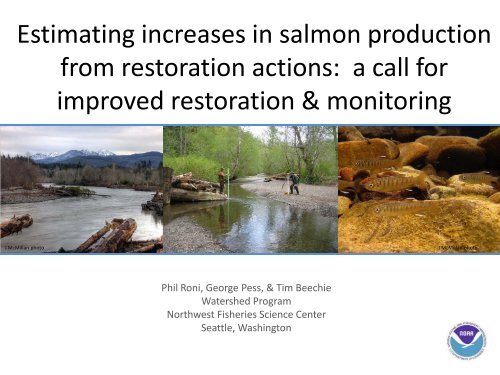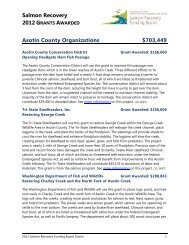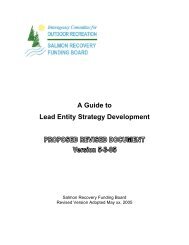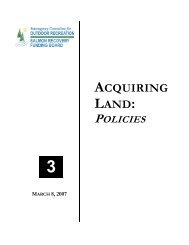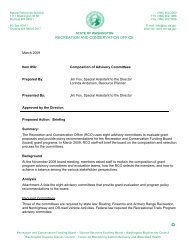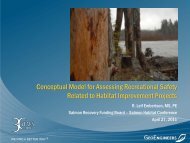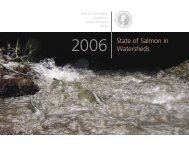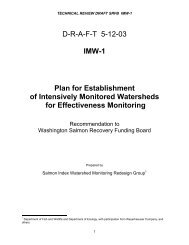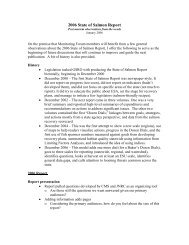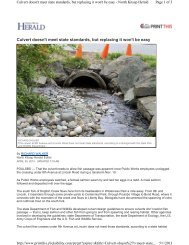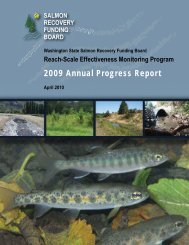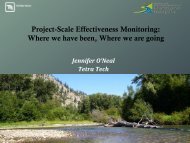Estimating increases in salmon population metrics from habitat ...
Estimating increases in salmon population metrics from habitat ...
Estimating increases in salmon population metrics from habitat ...
You also want an ePaper? Increase the reach of your titles
YUMPU automatically turns print PDFs into web optimized ePapers that Google loves.
<strong>Estimat<strong>in</strong>g</strong> <strong><strong>in</strong>creases</strong> <strong>in</strong> <strong>salmon</strong> production<strong>from</strong> restoration actions: a call forimproved restoration & monitor<strong>in</strong>gJ McMillan photoJ McMillan photoPhil Roni, George Pess, & Tim BeechieWatershed ProgramNorthwest Fisheries Science CenterSeattle, Wash<strong>in</strong>gton
Pacific Coastal Salmon Recovery FundRestoration <strong>in</strong> region
Many People Ask<strong>in</strong>g• How many more fish are we gett<strong>in</strong>g?• How much restoration for recovery?• How much before I can detect with monitor<strong>in</strong>g?
Answer Typically GivenWell….we don’t know enough about fishresponse to restoration yet……..give me afew more years and I can tell you!
Published Studies Evaluat<strong>in</strong>g RestorationRoni et al. 2008
Goals• <strong>Estimat<strong>in</strong>g</strong> watershed‐scale <strong><strong>in</strong>creases</strong> <strong>in</strong> smoltsus<strong>in</strong>g exist<strong>in</strong>g monitor<strong>in</strong>g data• Estimate how much restoration is needed todetect an <strong>in</strong>crease <strong>in</strong> fish numbers?• Suggestions for improv<strong>in</strong>g restoration &monitor<strong>in</strong>g
Methods• Estimate mean fish response to common techniques basedon exist<strong>in</strong>g monitor<strong>in</strong>g data• Scale up project level response to watershed scale.• Apply mean fish response to two different restorationstrategies <strong>in</strong> a typical Puget Sound watershed– Restore all– Historic• Monte Carlo simulation to estimate distribution of possibleresponsesRoni et al. 2010 NAJFM for details on methods
CanadaRestoration Types Exam<strong>in</strong>ed• Log placement <strong>in</strong> small streamsWash<strong>in</strong>gton(30 sites; Roni and Qu<strong>in</strong>n 2001)• Boulder structures <strong>in</strong> streams(13 sites; Roni et al. 2008)• Barrier removal(6 sites; Pess et al. 1998)• Constructed logjams(1 site; Pess et al. In press)Oregon• Floodpla<strong>in</strong> rehab(30 sites; Roni et al. 2006)• Groundwater channel(11 sites; Morley et al. 2005)California
Increase <strong>in</strong> smolts by project typeMean Increase <strong>in</strong> Smolts0.900.70CohoSteelheadn = 6Smolts per m or m 20.500.300.10n = 30 n = 18n = 1 n = 30 n = 11-0.10LWD Boulder weirs Logjams Floodpla<strong>in</strong> GroundwaterchannelsBarrierremoval-0.30Roni et al. 2010. NAJFM
Typical Puget Sound WatershedSalmon Habitat Typical WatershedStreams/Rivers (km)small* – <strong>in</strong>accessible 13small* – accessible 126medium* 58large* 118Floodpla<strong>in</strong> <strong>habitat</strong> (ha)Side channels exist<strong>in</strong>g 213Side channels lost 307Sloughs exist<strong>in</strong>g 77Sloughs lost 320*Small =
Restoration Actions Applied to WatershedSalmon HabitatStreams/Riverssmall – <strong>in</strong>accessiblesmall ‐ accessiblemediumlargeRestoration typeBarrier removalLWD additionBoulder weirsLogjamsFloodpla<strong>in</strong> <strong>habitat</strong>lost side channelslost sloughsGroundwater channelsFloodpla<strong>in</strong> reconnection
Increase <strong>in</strong> Coho SmoltsScenario 1 –Restore All Habitat1200Mean = 285,302Frequency100080060040095%prediction<strong>in</strong>terval95%prediction<strong>in</strong>terval2000Estimated <strong>in</strong>crease <strong>in</strong> coho <strong>salmon</strong> smolts
Increase <strong>in</strong> Steelhead SmoltsScenario 1 –Restore All HabitatFrequency9008007006005004003002001000Mean = 28,001Estimated <strong>in</strong>crease <strong>in</strong> steelhead smolts
Pacific Coastal Salmon Recovery Fund 2000 ‐2009Restoration <strong>in</strong> region
Restoration Scenario 2 ‐Historic PCSRF 2000‐2009Restoration ActivityPugetSoundBas<strong>in</strong>AveragePerWatershedInstream treated (km) 56 3Floodpla<strong>in</strong> hectares restored 53 3Culvert/barrier removal (km) 305 17* Only <strong>in</strong>cludes actions reported <strong>in</strong> PCSRF database
Increase <strong>in</strong> Coho SmoltsScenario 2 –Historic PCSRF1400mean = 17,270Mean = 15,02212001000Frequency8006004002000-15,432-7,669947,85815,62123,38531,14838,91146,67554,438Estimated <strong>in</strong>crease <strong>in</strong> coho smolts
Increase <strong>in</strong> Steelhead SmoltsScenario 2 –Historic PCSRF1400mean = 1,448Mean = 1,19512001000Frequency8006004002000-1300 -700 -100 500 1100 1700 2300 2900 3500 4100 MoreIncrease <strong>in</strong> steelhead smolts
Summary of Estimates <strong>in</strong> Model WatershedStrategyCohosmoltsSteelheadsmoltsPre‐restorationsmolt production 230,501 22,386Scenario 1 –Restore All 285,302 28,001Scenario 2 ‐ Historic 15,022 1,195
How much restoration is needed to detect an<strong>in</strong>crease <strong>in</strong> smolts with monitor<strong>in</strong>g?CohoSteelheadMean smolt production 230,501 22,386M<strong>in</strong>imum detectabledifference (25%) 57,625 5,596Habitat restoration neededto <strong>in</strong>crease smolts 25% 20%* 20%*• 100% to be 95% certa<strong>in</strong>
What???!
How Can We Improve Project Success?• Address limit<strong>in</strong>g <strong>habitat</strong> or life stage• Improved design & implementation• Other restoration techniques• IMPROVED MONITORING
Increase <strong>in</strong> smolts by project typeMean Increase <strong>in</strong> Smolts0.900.70CohoSteelheadn = 6Smolts per m or m 20.500.300.10n = 30 n = 18n = 1 n = 30 n = 11-0.10LWD Boulder weirs Logjams Floodpla<strong>in</strong> GroundwaterchannelsBarrierremoval-0.30Roni et al. 2010.
Improved Monitor<strong>in</strong>g• Treatments and Controls
Monitor<strong>in</strong>g Elwha Ch<strong>in</strong>ook Recovery25%
Parameters Other Than Smolt #• Survival• Pop. growth rate• Growth• OtherJ McMillan photo
Conclusions• More Restoration & or More Concentrated• Better Projects & Implementation• IMPROVED MONITORING & EVALUATION
Contribution by restoration type100%75%50%25%BarrierFloodpla<strong>in</strong>In‐channel0%Coho ‐ allSteelhead ‐ all
Contribution by restoration action100%75%50%25%BarrierFloodpla<strong>in</strong>In‐channel0%Coho ‐ all Steelhead ‐ all Coho ‐ PCSRF Steelhead ‐ PCSRFRestore Entire WatershedPCSRF –Historic Restoration


